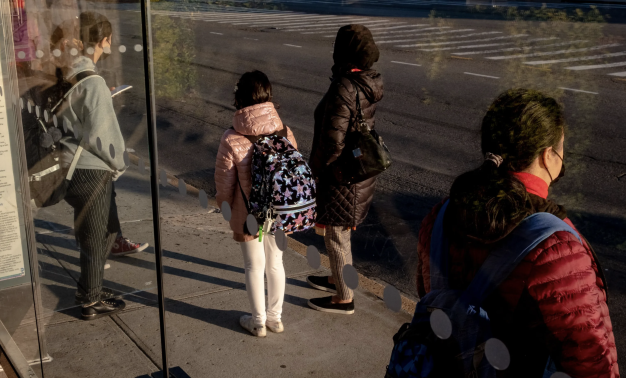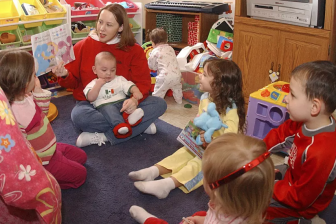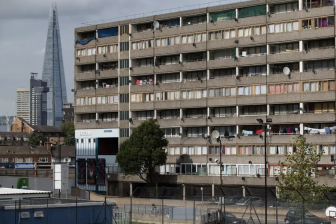
USA: As family homelessness climbs, calls grow louder for solving school attendance woes
Nine-year-old ‘Ameerah’ remembers when her commute to school was a five-minute walk. That was before her family left their Queens home in New York City for a shelter in another part of the borough.
During the year they lived in the shelter, Ameerah was at the bus stop with her mother and sister at 6:30 a.m., commuting at least 45 minutes on two buses and two trains. They often returned nearly 12 hours later, her mom said, and the girls were sometimes too tired to complete their homework in the evenings.
“My legs, sometimes they hurt. My backpack, it’s heavy,” Ameerah said during one of her bus rides last spring when she was in third grade. She fell behind in math, requiring her to go to summer school, says Reema Amin of Chalkbeat New York (Chalkbeat is using pseudonyms to protect the family’s privacy.)
Last school year, nearly 30,000 New York City public school students lived in shelters. For these students, getting to school is often a problem, as many are placed far from their current schools. Nearby shelters may lack space, or if the family is in a domestic violence situation, they may be deliberately placed far from home. Shelter transfers can be hard to come by. So families must often choose between punishing commutes like Ameerah’s or transferring schools, which research shows can lead to chronic absenteeism and the need to repeat a grade.
Chronic absenteeism – often a key indicator of academic performance – is a growing problem for students citywide following the pandemic. But for homeless students, it’s a crisis: 64 per cent of students living in shelters were chronically absent in the 2020-21 school year, meaning they were absent for at least 10 per cent of school days, according to the most recent data obtained by Advocates For Children. That’s compared with about 30 per cent of students citywide.
‘Chronic absenteeism is a growing problem’
Advocates fear attendance problems could worsen as homelessness continues rising to historic levels in New York City amid rising inflation, the end of the eviction moratorium, and the threat of a recession. Additionally, an influx of asylum-seeking students from South America have entered the shelter system. Last month, more than 12,100 families with children were in shelters run by the Department of Homeless Services, compared with roughly 8,500 in November 2021.
Ameerah’s family had little help navigating the shelter system and their school-related transportation needs, they said. This left her mom, Huma, an immigrant from Pakistan who sometimes struggled with English, to wade through bureaucracy while trying to work enough hours to qualify for subsidised housing. Many advocates believe that families can benefit from having a dedicated, shelter-based coordinator to support them and have been pushing the city to hire such staffers for the past year.
By June, the city had committed to hiring 100 such coordinators – 75 of them funded for the next two years with about $17 (USD) million of the $33 million in federal relief money earmarked for homeless students, according to Advocates For Children. (The education department declined to share how much the initiative would cost.)
But in the nearly five months since then, the city has hired just 45 of these coordinators, with another 33 in the hiring process, according to an education department spokesperson, who declined multiple times to explain why there has been a delay.
Dozens of advocacy organizations had originally called for 150 of these staffers, given that the city has more than 160 family shelters serving children. But now they’re concerned that the city hasn’t yet hired all of these staffers and are wondering what happens when the relief dollars run out in two years.
‘Failure to minimise disruptions to students’ schooling’
They also note that the problems go deeper than such a role can address and intersect with a variety of systemic issues, large and small, from intergenerational poverty to transportation issues.
Historically, there has been a failure to cooperate and minimise disruptions to students’ schooling between the multiple agencies connected to homeless children, including the education department and homeless services, said Jennifer Pringle, director of Project Learning In Temporary Housing at Advocates for Children.
This moment, in particular, is critical for figuring out solutions, said Pringle, whose organisation is one of more than three dozen calling for an inter-agency task force focused on how to tackle a slew of issues, including reducing chronic absenteeism among homeless students.
This is an opportunity to figure out, OK, as families are coming in, how can we make sure that kids are connected with school, connected with their peers, with their teachers,” Pringle said, “so that while the family is going through this process and ultimately finds permanent housing, the kids’ education doesn’t get derailed.
A longstanding federal law attempts to create some stability for students who become homeless. Under the McKinney-Vento Homeless Assistance Act of 1987, later expanded in 2001, school districts are required to provide transportation to and from a child’s “school of origin,” or the school they attended before becoming homeless.
But in vast New York City, students crossing between boroughs may have hours-long commutes between shelter and school. In response to news reports in 2017, then-Mayor Bill de Blasio pledged to ensure more families were placed in the same borough as their youngest child’s school.
His administration began to deliver on that promise. In 2018, about half of families were initially placed in shelters located in the same borough as their youngest child’s school. By last fiscal year, that grew by 11 percentage points, to three in every five families – including Huma’s. But even a shelter placement in the same borough can mean a challenging commute to school.
When there are school attendance issues, many shelter providers’ default position is to encourage families to change schools, Pringle said, rather than to revisit shelter placements and try to move families closer to their schools.
“In a city where we have so many shelter locations, the needs of children are not being prioritized as a part of this process,” she said.
For its part, a spokesperson for the Department of Social Services said their teams, along with the Department of Homeless Services, reach out to families in shelters “with longer commutes to schools, offering them shelter placements close to their youngest school-aged child’s school.” Last fiscal year, 75 per cent of families were in shelters in the same borough as their youngest child’s school; however, advocates noted that it’s unclear how much of that reflects children transferring schools instead of shelters.
‘Shelter placements close to their youngest school-aged child’s school’
When Ameerah’s family moved into one of New York City’s family shelters in April 2021, they had escaped what Huma described as an emotionally abusive home she had endured for many years. Adjusting to the shelter was tough. Even after the girls managed to fall asleep while sharing a bed in the small roach-infested room, the shelter’s 9pm bed-check often woke them up.
Huma’s case worker had asked where she wanted the children to attend school when they first entered the shelter. She thought that transferring schools felt disruptive, as the girls were returning to school for the first time since the onset of the pandemic while adjusting to a new, strange place.
“My kids, the big one especially, she is so sensitive now because of all this stuff,” Huma said, noting that they’d moved several times in the past. “She said, ‘I’m so tired from moving, every single time I change my school, but this time I don’t want to change my school. I like my school.’”
And for her younger daughter, arriving at school each day felt like a silver lining. She enjoyed seeing her friends and said that “time goes a little bit faster there.”
Transferring schools can have significant drawbacks for students without stable housing. One study from 2015 found that New York City students who transferred schools were more likely to be chronically absent, missing at least 10 per cent of school days. Chronically absent homeless children were three times more likely to repeat the same grade, compared to their homeless peers who missed fewer than five days of school, that report found.
Students in shelters in kindergarten through sixth grade are eligible for bus transportation to their schools, no matter where they are. Older students, like Huma’s eldest daughter, Ayaneh, who was about to start seventh grade, receive a MetroCard, though some seventh and eighth graders can get busing on a case-by-case basis, such as if they have a disability. But Huma, who felt that Ayaneh wasn’t yet ready to take public transportation on her own, said this information wasn’t shared with her until weeks into the school year. (The city’s yellow bus system is also notoriously problematic, and a recent City Council report found that service delays have been higher this fall than the past five years.)
Transferring schools can have significant drawbacks for students without housing
After Huma called the girls’ schools for more information on busing, school staff directed her to a general education department telephone line for transportation issues, she said. She didn’t call it.
“I said, ‘I just need the answer if you’re not providing a bus,’” she said of shelter staff. “They just kept promising it, but it never came.”
Huma didn’t trust that calling the education department would solve her issues. That might be why officials there said they did not have records of transportation issues or complaints related to her children.
There are 117 “family assistants” working across shelters, who are supposed to inform families about their school transportation rights, provide route information, and help with enrollment. But those employees don’t work year-round and often are not equipped to untangle more complicated problems, such as why a child may be chronically absent, advocates said.
The newly added shelter-based community coordinators would have broader responsibilities and are expected to proactively reach out to families living in shelters. They’re supposed to ensure students are getting to class, helping families navigate problems with transportation and enrollment using data compiled by the city. The education department is also using stimulus funds to better track homeless student attendance in hopes of working with shelters to address chronic absenteeism.
“There should be support services for families both at the shelter and at school that can help them with issues they might be facing, especially if there are attendance issues,” said Jacquelyn Simone, policy director for Coalition for the Homeless, an organization that advocates on behalf of homeless New Yorkers. “If someone is struggling to get to school, and it’s the proximity of the shelter to the school, then there should be, in an ideal world, a team that would identify the issue.”
Bus service eventually was set up for Ameerah by October of last year, a few weeks into the school year, Huma said. Ultimately, she decided against it because it no longer made sense. She would still need to accompany Ayaneh to school – and she would need to be with both girls to get back to the shelter since minors can’t go inside without a parent or guardian. This would prove a complicated juggling act as Huma tried to increase her work hours.
‘At least they have their bed and can sleep happy’
Like all shelter residents, Huma was eligible to apply for rental assistance after 90 days of her placement, but she needed to work at least 30 hours a week. After months of struggling to find employment, she took a job as a home health aide. Her job locations frequently changed, which made it more challenging to coordinate her daughters’ transportation to school, she said.
Meanwhile, Huma had been told that she needed a more stable work schedule in order to meet the qualifications for rental assistance.
Catherine Trapani, executive director of Homeless Services United, said she’s often found parents who struggle to meet their required number of work hours while also taking care of other responsibilities and following all shelter rules, such as ensuring children are accompanied at the shelter.
“It’s very difficult to get your employment in with that schedule, plus your obligations to cart your children to and from school, particularly if you don’t have a robust network of support,” Trapani said.
In a sign that job requirements had become too burdensome to qualify for the city’s rental subsidy requirements, city officials recently cut in half the required weekly work hours from 30 hours to 14.
After a lot of back-and-forth providing pay stubs and other employment documents, Huma was approved for subsidized rent in March of this year – seven months after her caseworker informed her that she would start the process. That was much longer than the median 26 days it took for families to receive vouchers after completing applications last year, according to the annual Mayor’s Management Report.
Huma moved her family into their own apartment in May. Nearly 5,200 homeless families found permanent housing last fiscal year, a 30 per cent drop from the previous year, according to city data.
Their new commute still required two buses for the girls to get to school, but their travel time was cut by 20 minutes.
But the instability has not gone away. Shortly before school started, Huma had attached a $622 utility bill to the fridge, marked with a bolded “final notice.” Huma was bringing in about $450 a week, and typically had nothing left after paying rent and other bills. Food stamps help provide some respite, she said. But she left her job in October after tensions with a patient’s caregiver, and she was still looking for work in December.
They’ve acknowledged that the apartment is not perfect. Their oven broke in the fall, and her landlord hadn’t arranged for it to be fixed. Carpet curled up at the edges of the walls. Still, the family seemed happy.
“At least they have their bed and they can sleep good,” the mother said.
Ayaneh still attends her middle school from last year. Her mother said she is seeing a therapist to deal with the family issues that caused them to seek shelter in the first place. In the end, Huma decided to change Ameerah’s school to one around the corner from their new apartment.
Reema Amin is a reporter covering New York City schools with a focus on state policy and English language learners.
This story was originally published by Chalkbeat, a non-profit news site covering educational change in public schools. Sign up for their newsletters at ckbe.at/newsletters.




